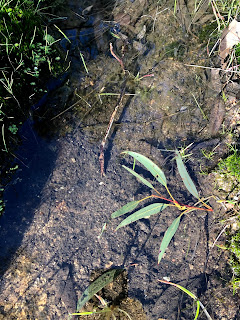Hello and thanks for reading this rather belated blog post. Things have been ridiculous this year, haven't they? COVID-19 seemed to be making things easier to start - no more travelling for work or horse events - but then things just got out of control with home schooling and working at home. I've been taking photos for this post though, so at least there's a consolation prize there!
This was shaping up to be a wet and relatively mild spring and summer with an El Nina originally slated as a 50% chance but this has firmed up to about 80% which is pretty fantastic. The rain and warmth has meant an absolutely bumper grass growth season and a lot of friends and farmers around the district are baling hay like their lives depend on it!
Our grasses have really flourished and we are very pleased with how the property looks at this stage, after only 4 years. The first two photos were taken in the first spring we moved onto the property. This was in 2016 and remains one of the wettest winters/springs on record for this area. It literally rained every day for 4 months. But even with this rain the ground cover is patchy and the majority of plant growth was flat weed (false dandelion) and cape weed.
 |
| December 2019 |
 |
| November 2020 |
 |
| October 2020 |
How did we do it? It's a combination of time, rest, judicious weed spraying and use of foliants and soil conditioners, and dung beetles. We only re-seeded small sections of the paddocks where the weeds were really thick and died off to leave bare earth, the rest is just natural seeding and fallow time. We have instituted a very strict system of rotation that means we have de-stocked a little, and will be selling three more horses in January, as well as resting and spraying for flat weed at certain times of the year. We use the Goode's Organics NPK with the MCPA selective herbicide, but also the Cal+Mag spray with a oil sticker in summer when not using a herbicide. Not much, to be honest, as spraying is so labour and time-intensive, but we think it's making a difference.
We are always learning more about plants, weeds and soils. We had a pretty serious infestation of storks bill, which is a nasty weed that invades hard and produces these ingenious pointy seed heads with long tails that burrow into the fur and wool. I panicked a bit the first early summer we saw this plant as it just took over, like cape weed. I did some reading on it and found it wasn't toxic to horses and they would sometimes eat it (though it does cause photosensitivity in sheep). Best of all, I knew from last summer that come the hot weather this weed would simply disappear. Also, healthy grasses just outcompete it.
And lo and behold, that is precisely what happened. I did spray two paddocks that were choked with it but I probably shouldn't have bothered. The paddocks are lush with grass and there is no discernible difference between the paddocks I sprayed and the ones I didn't. The MCPA is actually only partially effective on stork's bill anyway, so I was probably better not to bother.
The photos below show the way we still have to go before the paddocks are optimal.
 |
 |
 |
| Weeds are better than nothing - cape weed just starting to grow in bare earth |
Much like cape weed, this one just fades away and does no real harm. The worms love cape weed and I think this seasonal invasion of these two weeds is just part of the cycle now. The horses avoid them if they don't like them and there's not so much of either that they have no choice but to eat them.
We are excited and proud of the way the place is looking now. The grasses are so healthy and the horses in turn look wonderful. The only problem we've had this year, that we've never had before, is some laminitis in a few horses. Not full blown founder, but just some tenderness in the feet. We think this is due to the levels of clover in a couple of the paddocks and we've been spraying it back a little so that the horses can manage it. An ideal upper limit of 15-20% clover seems the way to go and we've been up over 30-35% in some paddocks!
More on that in the next blog!
Hope you're all well and safe and looking forward to more life getting back to normal as COVID restrictions are eased. Thanks for reading!
We are looking at hosting a couple of half and full day workshops on our property for those of you interested in learning more about how we are doing what we're doing. Get in touch if you'd be interested in coming along.



















